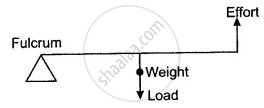Advertisements
Advertisements
प्रश्न
The following are an example of levers. State the class of lever to which each one belongs giving the relative positions of Load (L), Effort (E), Fulcrum (F):
(i) Scissors (ii) Sugar tongs (iii) Nutcracker (iv) Pliers.
उत्तर
| Name of Lever | Lever Class | Fulcrum | Position of Effort | Load | ||
| (i) | Scissors | First | At centre | One end | Other end | |
| (ii) | Sugar tongs | Third | One end | At centre | Other end | |
| (iii) | Nutcracker | Second | One end | Other end | At centre | |
| (iv) | Pliers | First | At centre | One end | Other end | |
APPEARS IN
संबंधित प्रश्न
The lever for which the mechanical advantage is less than 1 has :
Which type of levers have mechanical advantage always more than 1? Give reasons.
Give three examples for leavers of second order.
The following belong to which class of lever?
The Physical balance
The following belong to which class of lever?
Pliers Tools
The following belong to which class of lever?
Rowing of a boat
The following belong to which class of lever?
A fire tongs
The following belong to which class of lever?
Knife
Shears, used for cutting metals and scissors used for cutting clothes are both examples of levers of the first order. However, whereas the shears always have short blades and long handles, the scissors often have blades much longer than the handles. Explain, why this is so?
When we want to use a machine as a force multiplier, which class of lever should we preferably use? Give a simple diagram of such a lever.

